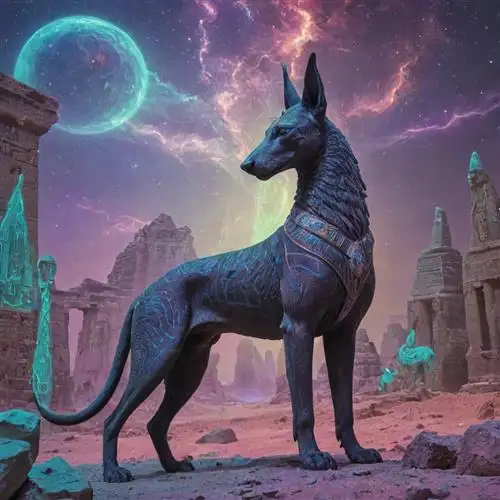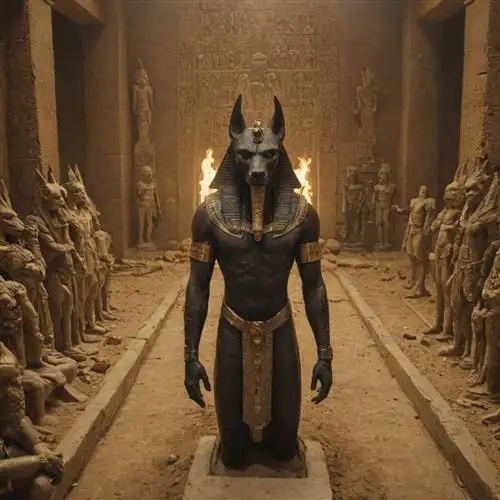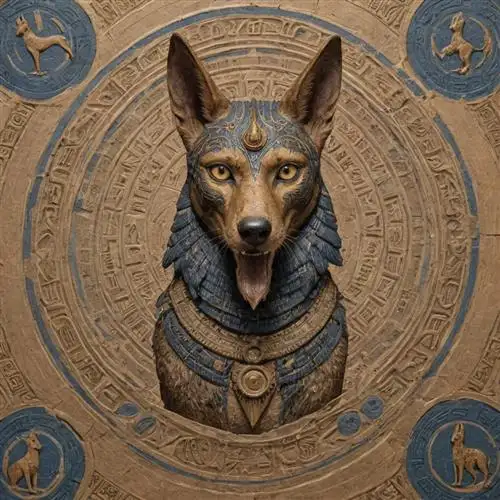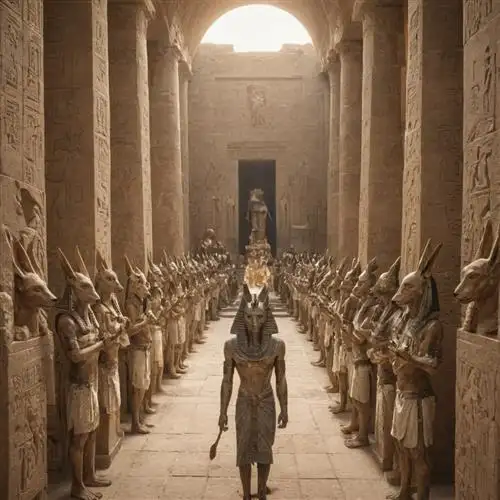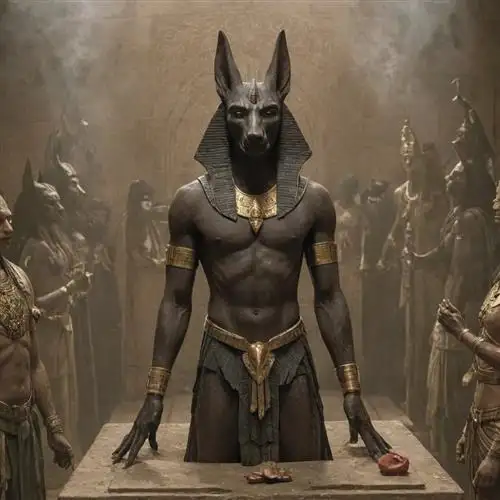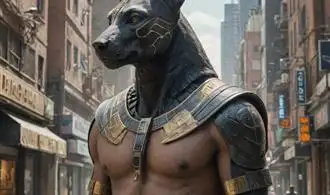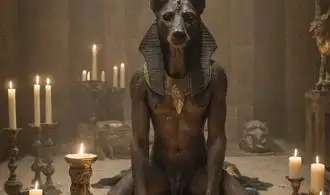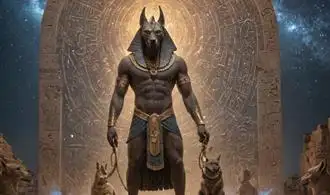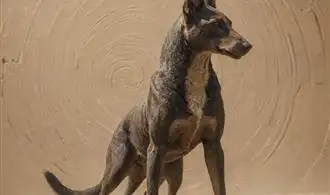
The Origins of Anubis
Anubis, the enigmatic Egyptian deity with the head of a jackal, has captivated the imaginations of scholars and enthusiasts alike. Tracing the origins of this ancient god can provide valuable insights into the intricate tapestry of Egyptian mythology and the evolution of religious beliefs in the Nile valley.
The earliest known depictions of Anubis date back to the Predynastic period, around 3100 BCE, where he was primarily associated with the process of mummification and the afterlife. As one of the oldest deities in the Egyptian pantheon, Anubis played a crucial role in the funerary rituals and the journey of the deceased through the underworld.
According to Egyptologists, the jackal-headed god may have originated from the deification of the wild canine species that roamed the deserts and necropoli of ancient Egypt. These scavengers were often observed near burial sites, and their presence may have been interpreted as a celestial guide leading the dead to the afterlife.
The name "Anubis" is believed to be derived from the Ancient Egyptian word "Anpu," which translates to "to decay" or "to decompose." This connection with the process of decomposition further strengthened Anubis' role as the guardian of the dead and the embalming process.
In the early dynastic period, Anubis was associated with the city of Cynopolis, also known as Abydos, which served as a major center of his cult. This region, renowned for its necropolis and funerary temples, became a significant pilgrimage site for those seeking the divine guidance of Anubis.
As Egyptian religious beliefs evolved, Anubis' role expanded beyond the realm of mummification and the afterlife. He was often depicted as the son of the deities Ra and Nephthys, further solidifying his position within the complex Egyptian pantheon.
The Roles and Responsibilities of Anubis
Anubis, the ancient Egyptian jackal-headed god, held a significant and multifaceted role in the pantheon. As the god of embalming and the afterlife, Anubis was responsible for guiding the deceased through the complex rituals and processes of the afterlife. One of his primary duties was the mummification of the dead, a practice that was essential for ensuring a smooth transition to the afterworld.
Anubis was believed to preside over the weighing of the heart ceremony, a crucial step in the journey of the deceased. During this ritual, the heart of the deceased was weighed against the feather of truth, representing the moral and ethical conduct of the individual. If the heart was found to be pure and virtuous, the individual was granted access to the afterlife. Anubis played a crucial role in this judgment, ensuring the fairness and accuracy of the proceedings.
Another significant responsibility of Anubis was to serve as a protective deity for the dead. He was believed to watch over the tombs and funerary rites, ensuring the safety and well-being of the deceased. This role extended beyond the physical realm, as Anubis was also thought to provide guidance and protection to the souls of the dead as they navigated the challenging landscape of the afterlife.
Anubis was also associated with the process of mummification itself. As the god who oversaw the embalming process, he was believed to possess the knowledge and expertise necessary to preserve the body in a state suitable for the afterlife. This made him a central figure in the rituals and ceremonies surrounding the preparation of the deceased for their eternal journey.
In addition to his roles related to the afterlife, Anubis was also believed to have guardianship over cemeteries and necropolis, the sacred cities of the dead. He was responsible for maintaining the sanctity and order of these sacred spaces, ensuring that the deceased could rest in peace and that the rituals and offerings made to them were properly observed.
The Iconography and Symbolism of Anubis
Anubis, the ancient Egyptian jackal-headed god, is a figure of immense significance in the pantheon of Egyptian deities. His iconography and symbolism are deeply intertwined with the beliefs and practices of the ancient Egyptians, reflecting the profound reverence and importance they placed upon this enigmatic god.
The jackal-headed form of Anubis is perhaps the most iconic and recognizable representation of the deity. This distinctive appearance is believed to be a symbolic link between the god and the jackal, an animal closely associated with the necropolis and the mummification process. Jackals were often observed prowling around ancient Egyptian burial sites, leading the Egyptians to associate them with the realm of the dead and the transition between life and the afterlife.
Anubis's role as the guardian of the dead and the embalming process is further emphasized through his symbolic connection to the mummification ritual. As the god responsible for overseeing the preparation of the deceased for their journey to the afterlife, Anubis is often depicted standing vigilantly beside the embalming table or performing the sacred rituals of mummification.
In addition to his role as the "Lord of the Sacred Land," Anubis was also revered as the patron of cemeteries and necropoli. His presence was thought to provide protection and guidance for the deceased, ensuring their safe passage to the afterlife. This association with the realm of the dead is further reinforced by Anubis's role in the weighing of the heart ceremony, a critical component of the Egyptian funerary rites.
The symbolic significance of Anubis's black coloration is another fascinating aspect of his iconography. The deep, jet-black hue of the jackal was believed to represent the fertile, dark soil of the Nile River valley, which was essential for the regeneration of life. This connection to the life-giving properties of the Nile likely contributed to Anubis's role as a deity of regeneration and rebirth.
The staff and flail, commonly depicted in Anubis's hands, are also rich in symbolic meaning. The staff represents authority and control, while the flail symbolizes the god's power to oversee and protect the deceased. These symbols, combined with Anubis's role as the guardian of the dead, underscore his position as a pivotal figure in the ancient Egyptian belief system.
The Cult and Worship of Anubis
Anubis, the enigmatic jackal-headed deity, held a significant place in the pantheon of ancient Egyptian gods. As the god associated with embalming and the afterlife, Anubis' cult was deeply intertwined with the sacred rituals and beliefs surrounding death and the journey to the afterlife. Delving into the intricacies of his worship reveals a complex and multifaceted aspect of ancient Egyptian religion.
The cult of Anubis was centered primarily in the region of Abydos, where he was revered as the patron deity of the necropolis and the protector of the dead. Anubis' role as the guardian of the dead was manifested in various ways, from overseeing the embalming process to guiding the deceased through the treacherous afterlife. The jackal-headed god was believed to be present at the crucial moment of judgment, where he would weigh the heart of the deceased against the feather of Ma'at, the goddess of truth and justice.
Anubis' importance in the afterlife was further reinforced by his association with the mummification process. The embalmers, who were considered to be priests of Anubis, would don the mask of the jackal deity during the embalming rituals, symbolically transforming themselves into the god himself. This ritual not only ensured the proper preservation of the body but also invoked the protective powers of Anubis to ensure the deceased's safe passage to the next life.
The worship of Anubis extended beyond the elite circles of priests and pharaohs. Commoners too sought the guidance and protection of the jackal-headed god, often through the use of votive offerings and prayers. Amulets and statues depicting Anubis were placed in tombs and funerary contexts, serving as talismans to safeguard the deceased and facilitate their journey to the afterlife.
The cult of Anubis also intersected with other deities in the Egyptian pantheon, most notably Osiris, the god of the underworld. Anubis was often depicted as the attendant or companion of Osiris, underscoring the interconnectedness of their roles in the afterlife. This association further solidified Anubis' status as a crucial figure in the Egyptian conception of the afterlife and the rituals surrounding death.
Anubis in the Afterlife and Funerary Rites
Anubis, the ancient Egyptian jackal-headed deity, played a crucial role in the afterlife and funerary rites of the ancient Egyptians. As the god of embalming and the protector of the dead, Anubis was integral to the complex rituals and beliefs surrounding the journey to the afterlife.
In the Egyptian funerary tradition, Anubis was responsible for the mummification process, ensuring the preservation of the deceased's body. He was believed to oversee the weighing of the heart ritual, a pivotal moment in the judgment of the dead. During this ceremony, the heart of the deceased was weighed against the feather of truth, representing the moral worthiness of the individual. Anubis would guide the soul of the departed through this critical evaluation, determining their fate in the afterlife.
Anubis also played a role in the various funerary rites and rituals that were performed to facilitate the deceased's journey to the afterlife. These included the opening of the mouth ceremony, which was believed to restore the senses and faculties of the dead, and the placement of canopic jars, which housed the internal organs of the mummified body.
Moreover, Anubis was believed to be the guardian of the necropolis, the sacred burial grounds where the dead were laid to rest. He was often depicted standing guard at the entrance to these hallowed spaces, ensuring the safety and sanctity of the deceased during their final resting place.
In addition to his role in the afterlife and funerary rites, Anubis was also associated with the embalming process itself. He was believed to have taught the ancient Egyptians the art of mummification, a practice that was crucial to the belief in the preservation of the physical body for the journey to the afterlife.

